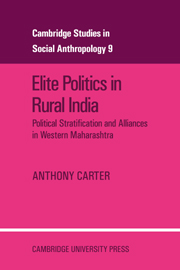 Elite Politics in Rural India
Elite Politics in Rural India from Part 2 - Aspects of political stratification
Published online by Cambridge University Press: 02 March 2010
The fundamental structural framework antecedent to political choice in Western Maharashtra is the division of the population into two categories: a dominant political class, consisting mainly of v∂t∂ndar Marathas, and the non-v∂t∂ndar masses. The elite position of the v∂t∂ndar Marathas has its origin in certain features of the traditional Maratha administrative system. Their continuing dominance is supported by their numerical predominance in the countryside and is reflected in as well as in part based upon their high ritual caste status. v∂t∂ndar Maratha dominance is also based on their control of wealth. They are a privileged economic class as well as a dominant political class.
Chapter 5 is an account of the distribution of wealth in Girvi. It is divided into four sections. In the first section I describe the land tenure system in Girvi and the distribution of rights in land among the various groups in the village. In the second section I describe the relations between agricultural laborers and their employers. The third section deals with the main sources of credit available to the villagers. The distribution of shares in co-operative societies is described in the fourth section.
In Girvi the v∂t∂ndar Marathas control the largest share of village land and the best quality land, as well. They also have privileged access to agricultural credit. They are the major employers of agricultural labor and they own a controlling share of village co-operatives. The system of land tenure and the credit institutions in Girvi are the same as those in other villages of Western Maharashtra.
To save this book to your Kindle, first ensure [email protected] is added to your Approved Personal Document E-mail List under your Personal Document Settings on the Manage Your Content and Devices page of your Amazon account. Then enter the ‘name’ part of your Kindle email address below. Find out more about saving to your Kindle.
Note you can select to save to either the @free.kindle.com or @kindle.com variations. ‘@free.kindle.com’ emails are free but can only be saved to your device when it is connected to wi-fi. ‘@kindle.com’ emails can be delivered even when you are not connected to wi-fi, but note that service fees apply.
Find out more about the Kindle Personal Document Service.
To save content items to your account, please confirm that you agree to abide by our usage policies. If this is the first time you use this feature, you will be asked to authorise Cambridge Core to connect with your account. Find out more about saving content to Dropbox.
To save content items to your account, please confirm that you agree to abide by our usage policies. If this is the first time you use this feature, you will be asked to authorise Cambridge Core to connect with your account. Find out more about saving content to Google Drive.